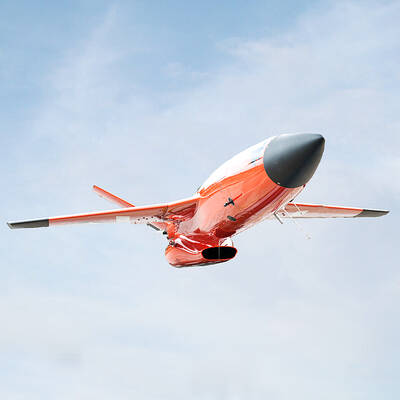Domestically developed Land Sword II (陸射劍二) missiles were successfully launched and hit target drones during a live-fire exercise at the Jiupeng Military Base in Pingtung County yesterday.
The missiles, developed by the Chungshan Institute of Science and Technology (CSIST), were originally scheduled to launch on Tuesday last week, after the Tomb Sweeping Day holiday long weekend, but were postponed to yesterday due to weather conditions.
Local residents and military enthusiasts gathered outside the base to watch the missile tests, with the first one launching at 9:10am.

Photo: Tsai Tsung-hsien, Taipei Times
The Land Sword II system, which is derived from the Sky Sword II (天劍二) series, was turned over to the army in May last year to replace its MIM-72A/M48 Chaparral surface-to-air missile system.
Three missiles were launched during the live-fire training.
A Ministry of National Defense report submitted to the Legislative Yuan last month showed that the army has leased target drones from the institute.
Starting this year, the Land Sword II missiles would be test-fired once each year, including the firing of three missiles and one target pursuit, the report said.
The Sky Sword system consists of an engagement control vehicle, a CSIST-developed Bee Eye radar system, a launch vehicle and an ammunition carrier, with an effective range of up to 15km, it said.
With the system, the vehicle crew can perform a 360o search, tracking and monitoring within the detection range, it said.
The system can detect enemy fixed-wing aircraft, rotary-wing aircraft, uncrewed vehicles and cruise missiles, and it can also be integrated with active Avenger missiles and twin-mounted Stinger missiles to bolster regional air defense capabilities, it said.
In other news, 11 Chinese People’s Liberation Army (PLA) aircraft crossed the median line of the Taiwan Strait or its extension in the 24-hour period starting at 6am on Sunday, the Ministry of National Defense said yesterday.
Eight of the aircraft crossed the median line, while three crossed the extension and entered Taiwan’s southwestern air defense identification zone (ADIZ).
Both groups consisted of an unspecified number of fighter jets and drones, flight paths and information released by the ministry showed.
Some of the aircraft flew as close as 41 nautical miles (76km) from the northern city of Keelung, the information showed.
In total, 18 PLA aircraft were detected in Taiwan’s ADIZ during the same period, while six PLA Navy vessels were also found to be operating in waters around the country, the defense ministry said.
The ministry said it deployed combat air patrol aircraft, navy vessels and coastal missile defense systems in response.
The ministry has stopped its practice of identifying the types of PLA aircraft detected in Taiwan’s ADIZ since Jan. 16.
Considering the changing security situation and threats, identifying the types of PLA aircraft could play into the hands of China, which could exploit this information to wage cognitive warfare campaigns against the Taiwanese public, military spokesman Major General Sun Li-fang (孫立方) said at the time.

‘WIN-WIN’: The Philippines, and central and eastern European countries are important potential drone cooperation partners, Minister of Foreign Affairs Lin Chia-lung said Minister of Foreign Affairs Lin Chia-lung (林佳龍) in an interview published yesterday confirmed that there are joint ventures between Taiwan and Poland in the drone industry. Lin made the remark in an exclusive interview with the Chinese-language Liberty Times (the Taipei Times’ sister paper). The government-backed Taiwan Excellence Drone International Business Opportunities Alliance and the Polish Chamber of Unmanned Systems on Wednesday last week signed a memorandum of understanding in Poland to develop a “non-China” supply chain for drones and work together on key technologies. Asked if Taiwan prioritized Poland among central and eastern European countries in drone collaboration, Lin

The Chien Feng IV (勁蜂, Mighty Hornet) loitering munition is on track to enter flight tests next month in connection with potential adoption by Taiwanese and US armed forces, a government source said yesterday. The kamikaze drone, which boasts a range of 1,000km, debuted at the Taipei Aerospace and Defense Technology Exhibition in September, the official said on condition of anonymity. The Chungshan Institute of Science and Technology and US-based Kratos Defense jointly developed the platform by leveraging the engine and airframe of the latter’s MQM-178 Firejet target drone, they said. The uncrewed aerial vehicle is designed to utilize an artificial intelligence computer

Renewed border fighting between Thailand and Cambodia showed no signs of abating yesterday, leaving hundreds of thousands of displaced people in both countries living in strained conditions as more flooded into temporary shelters. Reporters on the Thai side of the border heard sounds of outgoing, indirect fire yesterday. About 400,000 people have been evacuated from affected areas in Thailand and about 700 schools closed while fighting was ongoing in four border provinces, said Thai Rear Admiral Surasant Kongsiri, a spokesman for the military. Cambodia evacuated more than 127,000 villagers and closed hundreds of schools, the Thai Ministry of Defense said. Thailand’s military announced that

CABINET APPROVAL: People seeking assisted reproduction must be assessed to determine whether they would be adequate parents, the planned changes say Proposed amendments to the Assisted Reproduction Act (人工生殖法) advanced yesterday by the Executive Yuan would grant married lesbian couples and single women access to legal assisted reproductive services. The proposed revisions are “based on the fundamental principle of respecting women’s reproductive autonomy,” Cabinet spokesperson Michelle Lee (李慧芝) quoted Vice Premier Cheng Li-chiun (鄭麗君), who presided over a Cabinet meeting earlier yesterday, as saying at the briefing. The draft amendment would be submitted to the legislature for review. The Ministry of Health and Welfare, which proposed the amendments, said that experts on children’s rights, gender equality, law and medicine attended cross-disciplinary meetings, adding that